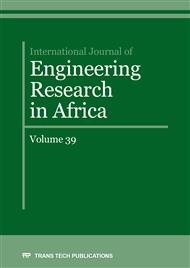p.86
p.97
p.112
p.119
p.139
p.147
p.156
p.170
p.191
Lead Retention on an Active Carbon Prepared from Date Kernels (Daglet Nour)
Abstract:
Metals occur naturally in rocks, water, air and soil and are also produced by human activities, including industrial and mining activities. For the most part, these heavy metals are hardly biodegradable, they are recognized, toxic or harmful to humans and animals. The use of activated carbon has remained for a long time and to this day the most effective adsorbent due to its high adsorption capacity mainly associated to its large specific surface. But this process is very expensive.This has therefore encouraged research by orienting them towards treatment processes using less costly and widely available natural materials. The objective of our study was to develop a simple, efficient and environmentally friendly sorption depollution technique on available and inexpensive media. We have studied the adsorption of lead on activated carbons prepared from date kernels. Batch tests were carried out with synthetic lead solution in order to study different operating parameters such as the effect of contact time, pH, initial lead concentration and adsorbent dosage. The results obtained showed that the adsorption capacity of the lead ions increase with increase in time until a saturation plateau was reached. The equilibrium was reached after a time close to 120 min and a plateau was observed from 120 to 180 min. The adsorption of lead on this adsorbent obeys the laws of Freundlich and Langmuir with a maximum capacity of 16.613 mg / g. Finally, we think that the results obtained during this study at the laboratory scale, confirm the interest practical and economical use of these two materials in the field of water treatment.
Info:
Periodical:
Pages:
139-146
Citation:
Online since:
November 2018
Authors:
Keywords:
Price:
Сopyright:
© 2018 Trans Tech Publications Ltd. All Rights Reserved
Share:
Citation:


